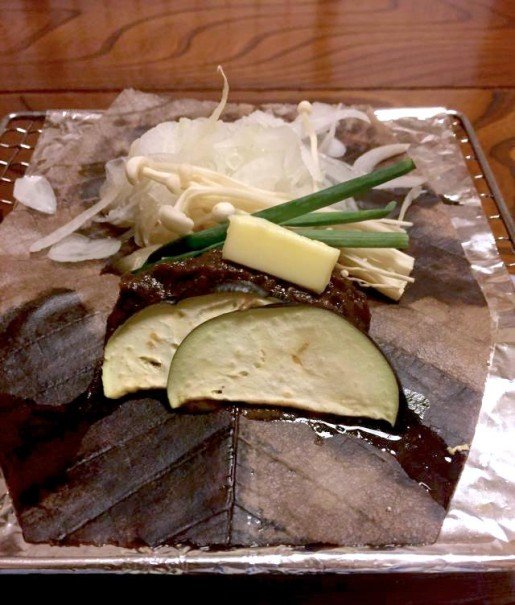
Eating on and Among Japan’s Magnolia Leaves

Eating on and Among Japan’s Magnolia Leaves
Hoba Miso in Takayama City
It was just about dawn when I awoke in my ryokan. I walked down the hall, slipped off my sandals, and slid open the translucent shoji doors. On the table before me were about a dozen little dishes, but the one to capture my attention sat above a little flame that jumped from a coal-fueled, cast iron cauldron. The flame licked the grill above it and did the same to the underside of a large green leaf. I walked across the tatami mats and settled down before the meal.
Atop the leaf, besides some mountain mushrooms and a scattering of sliced scallions, was a brown paste that had been laid in the middle; the edges of it bubbled and caramelized.
The breakfast is known as hoba miso, and it is quite common in Japan’s Takayama City, one of the prominent cities of the Japanese Alps, despite the dish’s unlikely components: it combines inedible waxy Magnolia obovata leaves with fermented miso paste, a foodstuff that is better known for flavoring broth than for being served as a breakfast entree.
The magnolia leaf, which substitutes for a frying pan, resists the flame for the better part of half an hour. (These leaves, which grow broad in the endless forests of the area, have also long-served as Japan’s original answer to Tupperware, preserving foods like raw fish. However, these days, finding the truly large magnolia leaves is less common.) The fermented soy bean paste is often mixed with other Japanese staples (like sweet tea sake or black sesame seeds), flavored with a few ingredients more typical to kitchens around the world (a dash of sugar, or perhaps eggs and nuts), and complemented with vegetables like Japanese leeks and shiitake mushrooms.
I snapped up some rice with my chopsticks and scraped up the dark and glutinous miso. A pair of mountain mushrooms—one yellow and one black—came up with the paste. Scallion rings were half submerged in the bite on my chopsticks, sunk in the brown like failing green life preservers. The umami-filled bite was mingled with the flavors of nutty and salty and sweet. While the kaiseki-style breakfast—think Japan’s answer to Spain’s tapas, but in the morning—featured another dozen or so dishes, the meal revolved around the ball of fire at the center of my table. Every other bite brought me back to the hot hoba miso, as it offered both the balance and sustenance I needed before my hike through the Alps, where I would tramp beneath the magnolia leaves.